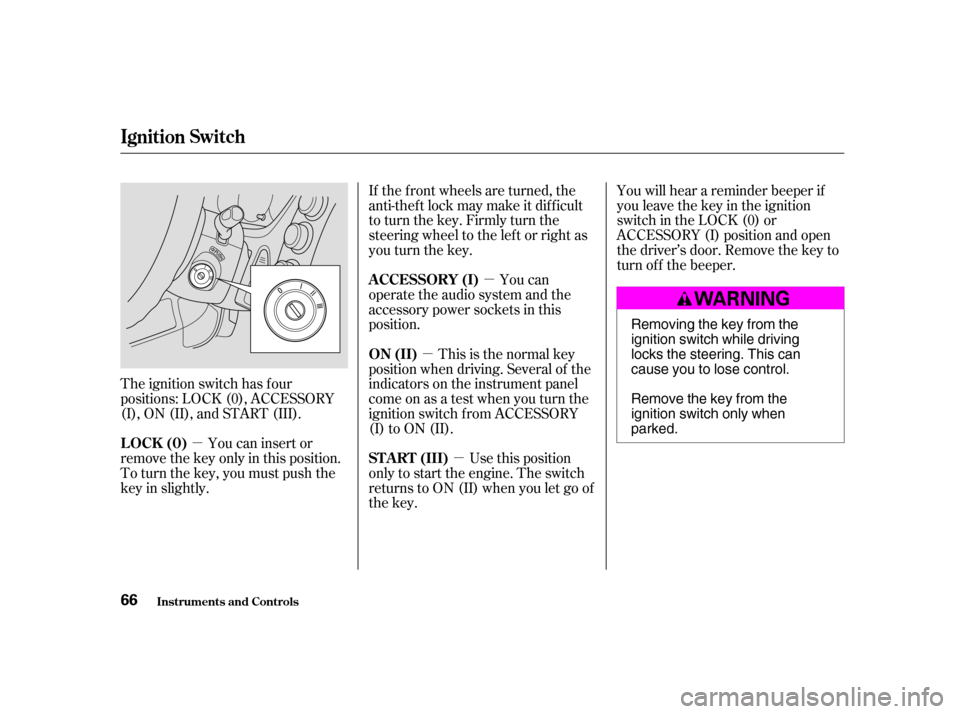Page 48 of 215

This section gives inf ormation about
the controls and displays that
contribute to the daily operation of
your Honda. All the essential
controls are within easy reach............................
Control Locations . 50
..........
Instrument Panel Indicators . 51
.............................................
Gauges . 57
...............
Odometer/Trip Meter . 57
..................................
Fuel Gauge . 57
...................
Temperature Gauge . 58
Controls Near the Steering ...........................................
Wheel . 59
.
Windshield Wipers and Washers . 60
...........
Turn Signal and Headlights . 61
........
Instrument Panel Brightness . 62
.................
Hazard Warning Button . 62
.................
Rear Window Def ogger . 62
..........
Steering Wheel Adjustment . 63
...............................
Keys and Locks . 64
........................
Immobilizer System . 65
................................
Ignition Switch . 66
......................................
Door Locks . 67
......................
Power Door Locks . 67
............................................
Hatch . 68
.......................
Remote Transmitter . 69
.................................................
Seats . 71
...........................
Cargo Area Cover . 75
..............................
Power Windows . 76
.........................................
Moonroof . 78
.............................................
Mirrors . 79 .................................
Parking Brake . 80
.................................
Interior Lights . 81
...........
Interior Convenience Items . 82
.......................
Beverage Holders . 83
....................................
Glove Box . 83
..........
Accessory Power Sockets . 83
...............
Console Compartment . 83
Instruments and Controls
Inst rument s and Cont rols 49
�����—�����—�����y�
������
������y���
�(���)�������y���������y
Page 58 of 215
�Î
�Î To use the horn, press the pad around the ‘‘H’’ logo.
Inst rument s and Cont rols
Controls Near the Steering Wheel
59
REAR WINDOW DEFOGGER
MIRROR CONTROLS TILT ADJUSTMENTHORN
HEADLIGHTS/TURN SIGNALS
WINDSHIELD WIPERS/WASHERS
(P. 61) (P. 60)
(P. 62)
CRUISE CONTROL
SWITCHES
(P. 105)
(P. 79) (P. 63)
(P. 62)
CRUISE CONTROL
MASTER SWITCH
(P. 105)
HAZARD WARNING BUTTON
�����—�����—�����y�
�������������y���
�(���)�������y���������y
Page 62 of 215

Make sure the rear window is clear
and you have good visibility bef ore
starting to drive.
Thedefoggerwiresontheinsideof
the rear window can be accidentally
damaged. When cleaning the glass,
always wipe side-to-side.Make any steering wheel adjustment
bef ore you start driving.
To adjust the steering wheel upward
or downward:
Push the lever under the steering
column all the way down. Move the steering wheel so it
points to your chest, not toward
yourface.Makesureyoucansee
the instrument panel gauges and
indicators.
Push the lever up to lock the
steering wheel in that position.
Make sure you have securely
locked the steering wheel in place
by trying to move it up and down.
1.
4.
3.
2.
See page f or important saf ety
inf ormation about how to properlyposition the steering wheel. 16
Rear Window Def ogger, Steering Wheel A djustment
Inst rument s and Cont rols
Steering Wheel A djustment
63
Adjusting the steering wheel
position while driving may
cause you to lose control of the
vehicle and be seriously injured
inacrash.
Adjust the steering wheel only
when the vehicle is stopped.
�����—�����—�����y�
���������
�
�y���
�(���)�������y���������y
Page 65 of 215

�µ
�µ
�µ �µ
The ignition switch has f our
positions: LOCK (0), ACCESSORY
(I), ON (II), and START (III). If the f ront wheels are turned, the
anti-thef t lock may make it dif f icult
to turn the key. Firmly turn the
steering wheel to the lef t or right as
you turn the key.
You can
operate the audio system and the
accessory power sockets in this
position.
Use this position
only to start the engine. The switch
returns to ON (II) when you let go of
the key. You will hear a reminder beeper if
you leave the key in the ignition
switch in the LOCK (0) or
ACCESSORY (I) position and open
thedriver’sdoor.Removethekeyto
turn of f the beeper.
You can insert or
remove the key only in this position.
To turn the key, you must push the
key in slightly. This is the normal key
position when driving. Several of the
indicators on the instrument panel
come on as a test when you turn the
ignition switch f rom ACCESSORY
(I) to ON (II).
A CCESSORY (I)
ST A RT (III)
LOCK (0) ON (II)
Ignition Switch
Inst rument s and Cont rols
66 Removing the key from the
ignition switch while driving
locks the steering. This can
cause you to lose control.
Remove the key from the
ignition switch only whenparked.
�����—�����—�����y�
�������������y���
�(���)�������y���������y
Page 88 of 215

Air conditioning, as it cools, removes
moisture from the air. When used in
combination with the heater, it
makes the interior warm and dry.Switch the f an on.
Turn on the air conditioning.
Select and Fresh Air mode.
Adjust the temperature control
dial to your pref erence.
This setting is suitable f or all driving
conditions whenever the outside
temperature is above 32°F (0°C). To remove f og f rom the inside of the
windows:
Select . The system
automatically switches to Fresh
Air mode and turns on the A/C.
(The A/C indicator will not comeon.)
Select .
Set the f an and temperature
controls to maximum level.
When you switch to another mode
f rom , the A/C stays on.
Press the A/C button to turn it of f . To clear the windows f aster, you can
close the dashboard corner vents by
rotating the wheel below it. This will
send more warm air to the
windshield def roster vents. Once the
windshield is clear, select the Fresh
Air mode to avoid f ogging the
windows.
For your saf ety, make sure you have
a clear view through all the windows
bef ore driving.
Set the f an to the desired speed.
Select , the system
automatically switches to Fresh
Air mode and turns on the A/C.
(The A/C indicator will not comeon.)
Adjust the temperature control
dial so the airflow feels warm.
Select to help clear the
rear window.
1.2.3.4.
1. 2. 3.
1.2. 3. 4.
Vents, Heating, and A/C
Comf ort and Convenience Feat ures
Dehumidif y the Interior T o Def og and Def rost T o Remove Exterior Frost or Ice
From the Windows
89
�����—�����—�����y�
�����������
�y���
�(���)�������y���������y
Page 104 of 215
Cruise control allows you to maintain
asetspeedabove25mph(40km/h)
without keeping your f oot on the
accelerator pedal. It should be used
f or cruising on straight, open
highways. It is not recommended f or
city driving, winding roads, slippery
roads, heavy rain, or bad weather.Push in the Cruise Control Master
Switch. The indicator in the switch
will light.
Accelerate to the desired cruising
speedabove25mph(40km/h).Press and release the SET/decel
buttononthesteeringwheel.The
CRUISE CONTROL indicator on
the instrument panel comes on to
show the system is now activated.
1. 2. 3.
CONT INUED
Cruise Control
Comf ort and Convenience Feat ures
Using t he Cruise Cont rol
105
RESUME/ accel
BUTTON
SET/decel
BUTTON
CANCEL BUTTON
Improper use of the cruise
control can lead to a crash.
Use the cruise control only
when traveling on open
highways in good weather.
�����—�����—�����y�
�������������y���
�(���)�������y���
�����y
Page 106 of 215

Even with the cruise control turned
on, you can still use the accelerator
pedal to speed up f or passing. Af ter
completing the pass, take your foot
of f the accelerator pedal. The vehicle
will return to the set cruising speed.
Resting your f oot on the brake or
clutch pedal will cause the cruise
control to cancel.Pressing the Cruise Control Master
Switch turns the system completely
of f and erases the previous cruising
speed.
Youcancancelthecruisecontrolin
any of these ways:
Tap the brake or clutch pedal.
Push the CANCEL button on the
steering wheel.
Press the Cruise Control Master
Switch. When you push the CANCEL
button, or tap the brake or clutch
pedal, the system remembers the
previously-set cruising speed. To
return to that speed, accelerate to
above25mph(40km/h)andthen
press and release the RESUME/
accel button. The CRUISE
CONTROL indicator comes on.
The vehicle will accelerate to the
same cruising speed as bef ore.
Cruise Control
Comf ort and Convenience Feat ures
Cancelling t he Cruise Cont rol
107
�����—�����—�����y�
�������������y���
�(���)�������y���
�
���y
Page 115 of 215

Removing parts f rom your vehicle,
or replacing components with non-
Honda (af termarket) components
could seriously af f ect your vehicle’s
handling, stability, and reliability.
Some examples are:Lowering your vehicle with an
aftermarket suspension kit that
signif icantly reduces ground
clearance can allow the
undercarriage to hit speed bumps
or other raised objects, which
could cause the airbags to deploy.
Raising your vehicle with an
af termarket suspension kit can
af f ect the handling and stability.
Af termarket wheels, because they
are a universal design, can cause
excessive stress on suspension
components. Larger or smaller wheels and tires
can interf ere with the operation of
your vehicle’s anti-lock brakes and
other systems.
Do not modif y your steering wheel
or any other part of your
Supplemental Restraint System.
Modif ications could make the
system inef f ective. See the saf ety
precautions on page .
If you plan to modif y your vehicle,
consult your Honda dealer. Improperly replacing
or covering f ront seat-back covers
can prevent your side airbags f rom
inf lating during a collision.
28
Modif ying Your Vehicle
Additional Saf ety Precaution
Bef ore Driving
A ccessories and Modif ications
Do not cover or replace f ront seat - back covers wit hout consult ing aHonda dealer.
116
�����—�����—�����y�
�����������
�y���
�(���)�������y���
�
���y